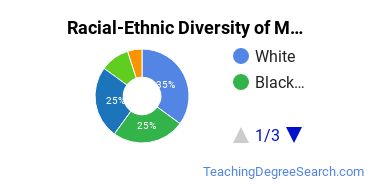Doctor’s Degrees in Multicultural Education
Education Levels of Multicultural Education Majors
During the most recent year for which data is available, 30 people earned their doctor's degree in multicultural education. This makes it the 35th most popular doctor's degree program in the country.
The following table shows the number of diplomas awarded in multicultural education at each degree level.
| Education Level | Number of Grads |
|---|---|
| Graduate Certificate | 157 |
| Master’s Degree | 144 |
| Basic Certificate | 48 |
| Doctor’s Degree | 30 |
| Bachelor’s Degree | 3 |
Earnings of Multicultural Education Majors With Doctor’s Degrees
At this time, we do not have the data to estimate the median earnings for this class of people.
Student Debt
We do not have the data to calculate the median and range of debt loads for multicultural education students who are doctor's degree holders.
Student Diversity
More women than men pursue their doctor's degree in multicultural education. About 90.0% of graduates with this degree are female.
| Gender | Number of Grads |
|---|---|
| Men | 3 |
| Women | 27 |

The racial-ethnic distribution of multicultural education doctor’s degree students is as follows:
| Race/Ethnicity | Number of Grads |
|---|---|
| Asian | 3 |
| Black or African American | 6 |
| Hispanic or Latino | 7 |
| White | 11 |
| International Students | 2 |
| Other Races/Ethnicities | 1 |

Most Popular Multicultural Education Programs for Doctor’s Degrees
There are 5 colleges that offer a doctor’s degree in multicultural education. Learn more about the most popular 5 below:
The most popular school in the United States for multicultural education students seekinga doctor's degree is University of San Francisco. Roughly 10,000 attend the school each year. The average in-state tuition for full-time undergraduates is $57,670 per year, while in-state graduate students, on average, pay $29,070 per year. During the most recent year for which we have data, 10 people received their doctor's degree in multicultural education from USFCA. About 93% of this group were women, and 60% were students from an underrepresented racial-ethnic group.
The 2nd most popular school in the country for multicultural education majors who are seeking their doctor's degree is Biola University. The average in-state tuition for full-time undergraduates is $46,704 per year, while in-state graduate students, on average, pay $12,420 per year. During the most recent year for which we have data, 7 people received their doctor's degree in multicultural education from Biola. Around 67% of these students were from an underrepresented racial-ethnic group, and 100% were women.
University of Colorado Boulder is the 3rd most popular school in the nation for students seeking a doctor's degree in multicultural education. The average in-state tuition for full-time undergraduates is $13,910 per year, while in-state graduate students, on average, pay $15,849 per year. During the most recent year for which we have data, 3 people received their doctor's degree in multicultural education from CU - Boulder. Around 50% of these students were from an underrepresented racial-ethnic group, and 100% were women.
Harvard University comes in at #3 on our list of the most popular colleges offering doctor's degrees in multicultural education. Each year, around 30,300 students seeking various degrees attend the university. The average in-state tuition for full-time undergraduates is $54,269 per year, while in-state graduate students, on average, pay $54,032 per year. During the most recent year for which we have data, 3 people received their doctor's degree in multicultural education from Harvard. Around 43% of these students were from an underrepresented racial-ethnic group, and 71% were women.
Explore Major by State
Alabama
Arkansas
Connecticut
Florida
Idaho
Iowa
Louisiana
Massachusetts
Mississippi
Nebraska
New Jersey
North Carolina
Oklahoma
Rhode Island
Tennessee
Vermont
West Virginia
Related Majors
Below are some popular majors that are similar to multicultural education that offer doctor’s degrees.
| Major | Annual Degrees Awarded |
|---|---|
| Bilingual & Multilingual Education | 6 |
| Indian/Native American Education | 1 |
References
*The racial-ethnic minority student count is calculated by taking the total number of students and subtracting white students, international students, and students whose race/ethnicity was unknown. This number is then divided by the total number of students at the school to obtain the percentage of racial-ethnic minorities.
- College Factual
- National Center for Education Statistics
- O*NET Online
- Bureau of Labor Statistics
- Image Credit: By DIAC images under License
More about our data sources and methodologies.




